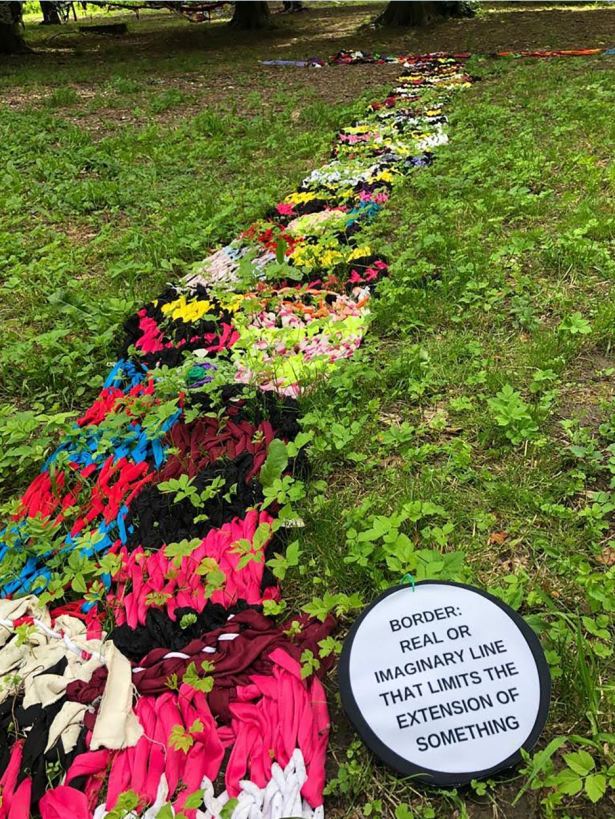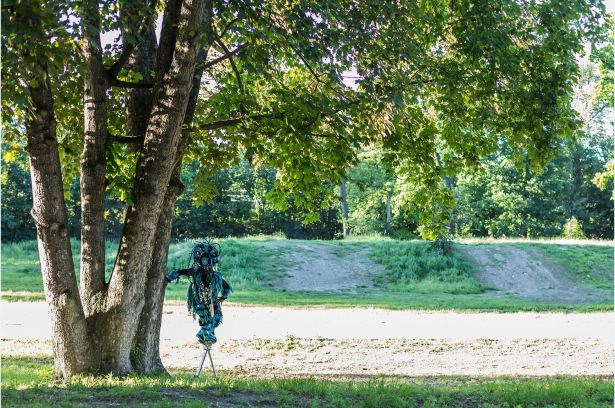Aris Pretelin-Esteves is a Mexican vegan scenographer and scenic artist who cares deeply about animals, plants, insects, humans, objects and places. Her work is about understanding herself as an artist with social responsibility and as part of a community. She creates open scenographic actions that promote opportunities for humans and nature to connect with one another and participate in the recovery of public spaces. Her materials include waste, the discarded and the abandoned.
How did your interest in Ecoscenography and sustainable theatre production begin?
It is almost like one day I woke up and realised that I was surrounded by garbage. I went out to the street and saw trees dying from lack of water, their roots breaking through the concrete. I got to the park and there was no grass, there were no flowers, there was nowhere to sit. Everywhere I turned there was garbage. I realised then that there was no sense in continuing to create, especially if the only thing I saw on the way to the theatre was death, neglect, concrete and bad smells!
What is the meaning of doing theatre if we are trapped inside creating fictional worlds while ours is falling apart? This question is what prompted me to look for ways to generate projects that could transform our dying city into one that was full of life. I started by reimagining the city as scenography, one in which we can all participate. I began to consider waste and ruin as possibilities for creation and artistic production. Since then, I have started incorporating these ideas into my work and forging a new path of creation that continues today.
What does Ecoscenography mean to you? How do you define it (for yourself and others)?
In my opinion, Ecoscenography is a way of thinking about myself as a scenographer as well as taking an inclusive approach to artistic production. It is not only about recycling or using waste materials. For me, it is a way of conceiving the scene, as well as the management, materialisation and transformation of the processes involved.
Ecoscenography also implies placing myself within my own urban context and accepting the responsibility that this entails. Working with community requires a diagnosis of needs: to engage in reflection and collective dialogue; to imagine alternatives for transformation; and to foster care in the way we live and inhabit spaces. Ecoscenography is a political-artistic position.
Ecoscenography offers a change in perspective that displaces pragmatic ideas of scenographic creation and proposes a horizontal, collective, transdisciplinary and participatory approach to making openly sourced and accessible works. This means that Ecoscenographers understand scenography and theatricality as a means of social, political, artistic and environmental transformation.
Can you tell me about TEJIDOS?
TEJIDOS is a project created with, for and by the community. It involves several scenographic actions that seek to transform urban green spaces into inclusive gathering places and aims to reverse the neglect and devastation that surrounds us.
TEJIDOS begins with the donation and recycling of discarded garments that participants later transform, weave, design and install in a green area of the city. The fabric acts as a guiding axis for the project and is a metaphor for the multiple networks that connects us to the environment and the broader world. The scenography for TEJIDOS is created collectively, and participants undertake a journey during which the green space and its surroundings are perceived from different points of view, unveiling the history-memory of the space and therefore, its natural liveliness. In creating a collective, tactile, and memorable experience, a convivial bond is woven, fostering a sense of care for our green spaces.
Knitting and weaving are simple somatic actions that, by their continuous repetition, relaxes the body and encourages participants to listen and engage in dialogue with one another. These conversations and ideas are subsequently shared with institutions, committees, and neighbourhood associations to generate agreements and actions that will transform and take care of green spaces in the long term.
TEJIDOS responds to a ‘Povera’ aesthetic, seeking the transformation of waste materials by exposing them to a natural environment that modifies and activates them and creates a sense of meaning. The richness of the project lies in its ability to promote ‘encounter-spaces’ for collective action – to regenerate the social fabric and to resist the social-environmental crisis that we are experiencing right now in Mexico.
What were some of the biggest hurdles that you have had to tackle on realising the project? What are you most proud of?
It is not common to have these kinds of projects in Mexico. Usually, they are either social or artistic, not both. Scenographers are generally trained as creators who are unaccustomed to letting other people take part in their designs and the relationships can be very hierarchical. In addition, we don’t really have an environmentally responsible culture. So, no one found it attractive to weave a scenography with recycled clothing, or to create an installation with people from the community. The truth is, nobody really understood it, at least to begin with. They wanted to know why I was doing it and what was it all for? And what was I going to gain with all that? And they could not categorise it! No one understood if it was a play, a workshop, an installation, or a social intervention. I answered that yes, it was all that!
Nevertheless, Pamela-Eliecer Badallo and I started the project without funding and without support. We were invited to PQ2019 so we joined our friends and colleagues Priscila Imaz, Nurydia Briseño and Jorge Hernández to start a garment donation campaign with neighbours, family, friends, schools and universities. We offered weaving workshops, and eventually many people who were not related to the theatre industry began to approach us, to support us with donations, and to talk about TEJIDOS with other people. And then, suddenly it became huge!
Many people started proposing ideas, donating materials, helping to structure the project and to assist in weaving. Soon colleagues who I had not spoken to for a long time appeared. Estela Fagoaga helped us to materialise the costumes, Miranda Aguayo supported with the realization of headdresses and costume details, the team of ‘Emprendedores Culturales’ supported us with the management of resources and Alma Carrascosa financed part of the project. Finally, we travelled to Prague carrying 200kg of fabric. And in the end, it was amazing!
During the last 3 years, we have met with Biologists, Social Workers, Professional Weavers, Photographers, Videographers who have enriched the project with their work and continue transforming it within the green areas in which we weave. I am proud that we have managed to bring together so many people to engage in meaningful conversations and create artistic works that are kinder to the environment and foster a better coexistence with humans and nature. I honestly don’t see myself working in any other way.
What tips would you give to a scenographer/theatre maker who is exploring sustainable practice for the first time?
- Always be consistent with what you believe. Your ethical stance is what will give meaning and validity to your proposal.
- Do not believe it when someone tells you that what you do does not make sense or is not valuable.
- Research is the basis of sustainability. If you don’t test and explore enough, you won’t have good results. Take time to investigate your materials, try things out until you get the desired result.
- Recycling is not enough. All material requires a transformation process, to develop greater possibilities for manipulation and therefore, creation.
- Talk about your work. Eventually there will be someone interested that will support you.
- Look beyond the black box. Scroll and look for ideas across other disciplines.
What is your next project?
COVID19 has revealed the importance of more suitable public spaces in Mexico. Tejidos has continued with some virtual interventions in the community with the intention of doing residencies in town halls and green areas as soon as we have the possibility. I firmly believe that we still have much work to do. There are many spaces to transform, many memories to recover and many communities to weave together. On another note, we have also been working on a project called ‘Continuous Stops – How to waste time in a city without time’ where we explore immobility as a resistance to a city that forces you to move forward regardless of social and environmental consequences.
(Top photo: Photo by Carlos Casasola, 2019)
The post, Encounter-spaces and the City as Scenography: Interview with Aris Pretelin-Esteves (Mexico), appeared first on Ecoscenography.
———-
Ecoscenography.com has been instigated by designer Tanja Beer – a PhD candidate at the University of Melbourne, Australia, investigating the application of ecological design principles to theatre.
Tanja Beer is a researcher and practitioner in ecological design for performance and the creator of The Living Stage – an ecoscenographic work that combines stage design, permaculture and community engagement to create recyclable, biodegradable and edible performance spaces. Tanja has more than 15 years professional experience, including creating over 50 designs for a variety of theatre companies and festivals in Australia (Sydney Opera House, Melbourne International Arts Festival, Queensland Theatre Company, Melbourne Theatre Company, Arts Centre) and overseas (including projects in Vienna, London, Cardiff and Tokyo).
Since 2011, Tanja has been investigating sustainable practices in the theatre. International projects have included a 2011 Asialink Residency (Australia Council for the Arts) with the Tokyo Institute of Technology and a residency with the Royal Central School of Speech and Drama (London) funded by a Norman Macgeorge Scholarship from the University of Melbourne. In 2013, Tanja worked as “activist-in-residence†at Julie’s Bicycle (London), and featured her work at the 2013 World Stage Design Congress (Cardiff)
Tanja has a Masters in Stage Design (KUG, Austria), a Graduate Diploma in Performance Making (VCA, Australia) and is currently a PhD candidate at the University of Melbourne where she also teaches subjects in Design Research, Scenography and Climate Change. A passionate teacher and facilitator, Tanja has been invited as a guest lecturer and speaker at performing arts schools and events in Australia, Canada, the USA and UK. Her design work has been featured in The Age and The Guardian and can be viewed at www.tanjabeer.com
Powered by WPeMatico









